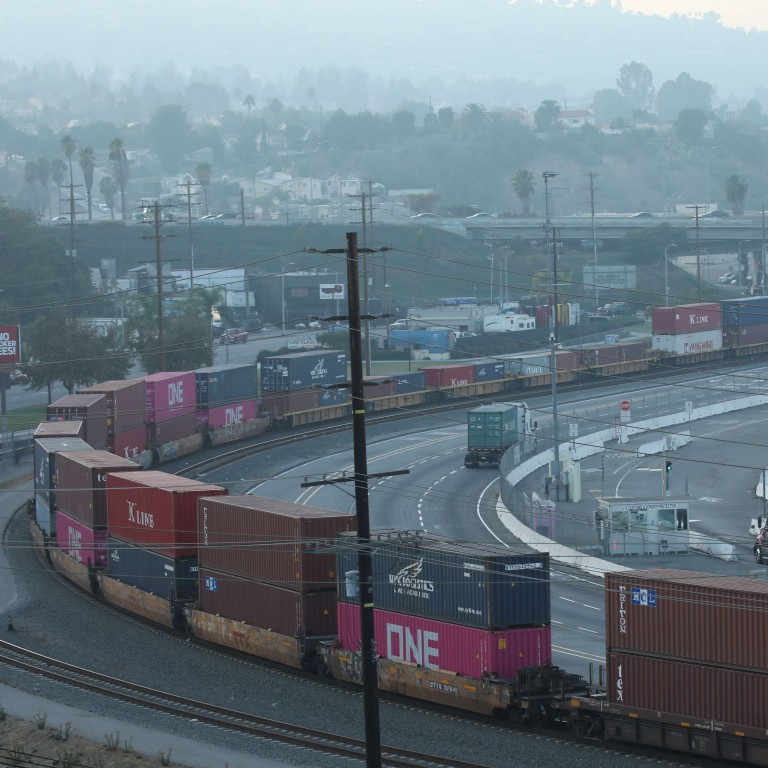
California, ‘ground zero for US-China relations’, feels the pinch as trade war tariffs hit American port traffic
- Trade volumes at the Port of Los Angeles and the Port of Long Beach dropped significantly in October, with last year’s frantic front-loading a distant memory
- Southern California is home to huge network of trade-related jobs, with new era of uncertainty sending ripples of concern through the industry
Karen Quintana used to pay little attention to US President Donald Trump’s Twitter feed. But as the US-China trade war has dragged on, monitoring the frequent social media dispatches has become an essential part of the job.
“At first, people did not really believe the tweets on tariffs were real. They thought, ‘oh he tweeted something, but maybe it’s not going to come true’. But now, we take them very seriously, when we get a notification that he is tweeting, we’re starting contingency planning, because otherwise you could be very easily caught off guard,” said Quintana, president of the Los Angeles Customs Broker and Freight Forwarders Association.
I talk to importers who still believe to the very last minute that things are going to be called off. But we have to plan now under the assumption that [what Trump tweets] is actually going to happen and how are we going to handle this
“I talk to importers who still believe to the very last minute that things are going to be called off. But we have to plan now under the assumption that [what Trump tweets] is actually going to happen and how are we going to handle this,” Quintana said.
“They are critically important economically to California because there are vast armies of people who work generally blue collar, sometimes temporary jobs, that are all linked to the volume of goods moving through the ports. And since so much of that originates [from] or is destined for China, any interruption to trade with China has a disproportionate impact on Southern California,” said Jock O’Connell, international trade adviser at Beacon Economics.
Ironically, those jobs numbers were boosted in the early months of the trade war, when US buyers rushed to front-load their stock, buying early from China before the tariffs hit. Floating finishing factories off the Californian coast – where goods were being hastily assembled before hitting the docks – were a common sight, as importers thought of ever more creative ways to get their goods into the country.
New figures released on Monday, however, showed that these days have gone – the feared interruption to California’s trade economy has arrived.
At the Port of Los Angeles, container traffic dropped 19.1 per cent in October, while the Port of Long Beach’s traffic fell by 2.4 per cent. Combined, the ports saw a 14.1 per cent drop in imports, with the trade war a significant factor.
Perhaps naturally, goods subject to tariffs have fallen off, but the effects of last year’s mammoth bout of front-loading are also still being felt. Available warehouse capacity is still low as companies do not need more imports, which in the long term will be bad news for the employment network emanating from the ports, some of which, is seasonal and ad hoc.
Moreover, as well as the direct jobs on the docks, there are myriad downstream jobs also dependent on US-China trade. For example, the typical maritime container is 40 feet long, while the containers used for trucking goods around the United States and North America are 53 feet. This has given rise to a huge network of warehouses and distribution centres in inland California, where the smaller containers are emptied of goods, which are then repackaged into the bigger units.
There is just so much volume coming to and from China for Southern California versus the other countries that it is challenging for any other country to keep up with it
For Quintana and the legion of customs brokers throughout California, the tariffs bring other issues beyond volume. Businesses in sectors like furniture or toys have been used to paying low duties on imports, but now pay as much as 25 per cent. This means that the customs bond paid on imports – a legal agreement that ensures all necessary duties, taxes, and fees are paid to customs when importing commercial goods – are much costlier than before.
Furthermore, many customs brokers are paying tariffs up front on behalf of their clients. If the trade slump continues, some may not be in a position to repay the tariff bills.
“All of this means more risk,” Quintana added. “If your business is decreasing and there's less cargo to move and clear, you have to adjust your staffing accordingly.”
While soybean farmers in Iowa or car makers in Michigan may argue differently, Matt Sheehan, a fellow at the Paulson Institute’s Macro Polo think tank, described California as “ground zero for this new era in the US-China relationship”.
“It's a microcosm where things happen first and in the greatest quantity, before rippling out through the rest of the country,” said Sheehan, whose recent book, The Transpacific Experiment, explored the depth of China-Californian ties, from Silicon Valley to third-level education and Hollywood movies.
“The idea that suddenly we're just going to get all of these factories from China to relocate back to the US and suddenly the trade is going to be balanced and everyone's going to be happy, that is a fantasy on many levels.”

